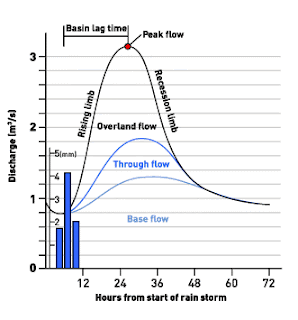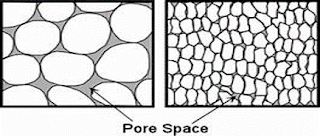HYDROGRAPH | there terminologies | type and factors effecting hydrograph
HYDROGRAPH: A hydrograph may be used to show how the water flow in a drainage basin (particularly river runoff) responds to a period of rain.
This type of hydrograph is known as a storm or flood hydrograph and it is generally drawn with two vertical axes. One is used to plot a line graph showing the discharge of a river in cumecs (cubic meters per second) at a given point over a period of time. The second is used to plot a bar graph of the rainfall event which precedes the changes in discharge. The scale on the horizontal axis is usually in hours/days and this allows both the rain event to be recorded and the subsequent changes in river discharge to be plotted. The shape of the hydrograph varies according to a number of controlling factors in the drainage basin but it will generally include the following features. The baseflow of the river represents the normal day to day discharge of the river and is the consequence of groundwater seeping into the river channel. The rising limb of the hydrograph represents the rapid increase in resulting from rainfall causing surface runoff and then later throughflow. Peak discharge occurs when the river reaches its highest level. The time difference between the peak of the rain event and the peak discharge is known as the lag time or basin lag. The falling limb (or recession limb as it is sometimes known) is when discharge decreases and the river’s level falls. It has a gentler gradient than the rising limb as most overland flow has now been discharged and it is mainly throughflow which is making up the river water.
TYPES OF HYDROGRAPH: -The following three important types of unit hydrographs,
(1) Normal or Average Unit Hydrograph (Av. UH),
(2) Dimensionless Unit Hydrograph, and
(3) Instantaneous Unit Hydrograph (IUH).
1. Average Unit Hydrograph: To obtain normal or average unit hydrograph for a basin several storms are taken and unit hydrographs plotted for each of them. Obviously, these unit hydrographs will be of different unit durations. They are then reduced to a suitable unit duration by the ‘S’ hydrograph method.
All such unit hydrographs of equal duration are then plotted on the same sheet overlapping each other with their peaks on the same ordinate. The unit hydrographs with wide peaks are neglected. Using the plotting's of other unit hydrographs a mean curve is drawn which gives normal or average unit hydrograph for that basin. This unit hydrograph may be tested by reproducing an observed flood by applying corresponding effective rainfall. Such a unit hydrograph is considered quite adequate for all design floods except probable maximum flood.
2. Dimensionless Unit Hydrograph: It is a unit hydrograph for which the discharge is expressed by the ratio of discharge to peak discharge and the time is expressed by the ratio of time to lag time. Knowing the peak discharge and lag time for the duration of effective rainfall the unit hydrograph can be estimated. The peak discharge qp and lag time may be estimated by Snyder method.
Advantages: 1. It eliminates effects of basin size and shape. It facilitates comparison of unit hydrographs of basin of different sizes and shapes.
ADVERTISEMENTS: It is an excellent means of averaging unit hydrographs.
3. Instantaneous Unit Hydrograph: If the duration of the effective rainfall becomes infinitesimally small, the resulting unit hydrograph is called instantaneous unit hydrograph (IUH) words, for an IUH the effective rainfall is applied to the drainage basin in zero time. Of course, this is only a fictitious situation and a concept to be used in hydrograph analysis.
FACTORS EFFECTING HYDROGRAPH:
This type of hydrograph is known as a storm or flood hydrograph and it is generally drawn with two vertical axes. One is used to plot a line graph showing the discharge of a river in cumecs (cubic meters per second) at a given point over a period of time. The second is used to plot a bar graph of the rainfall event which precedes the changes in discharge. The scale on the horizontal axis is usually in hours/days and this allows both the rain event to be recorded and the subsequent changes in river discharge to be plotted. The shape of the hydrograph varies according to a number of controlling factors in the drainage basin but it will generally include the following features. The baseflow of the river represents the normal day to day discharge of the river and is the consequence of groundwater seeping into the river channel. The rising limb of the hydrograph represents the rapid increase in resulting from rainfall causing surface runoff and then later throughflow. Peak discharge occurs when the river reaches its highest level. The time difference between the peak of the rain event and the peak discharge is known as the lag time or basin lag. The falling limb (or recession limb as it is sometimes known) is when discharge decreases and the river’s level falls. It has a gentler gradient than the rising limb as most overland flow has now been discharged and it is mainly throughflow which is making up the river water.
TYPES OF HYDROGRAPH: -The following three important types of unit hydrographs,
(1) Normal or Average Unit Hydrograph (Av. UH),
(2) Dimensionless Unit Hydrograph, and
(3) Instantaneous Unit Hydrograph (IUH).
1. Average Unit Hydrograph: To obtain normal or average unit hydrograph for a basin several storms are taken and unit hydrographs plotted for each of them. Obviously, these unit hydrographs will be of different unit durations. They are then reduced to a suitable unit duration by the ‘S’ hydrograph method.
All such unit hydrographs of equal duration are then plotted on the same sheet overlapping each other with their peaks on the same ordinate. The unit hydrographs with wide peaks are neglected. Using the plotting's of other unit hydrographs a mean curve is drawn which gives normal or average unit hydrograph for that basin. This unit hydrograph may be tested by reproducing an observed flood by applying corresponding effective rainfall. Such a unit hydrograph is considered quite adequate for all design floods except probable maximum flood.
2. Dimensionless Unit Hydrograph: It is a unit hydrograph for which the discharge is expressed by the ratio of discharge to peak discharge and the time is expressed by the ratio of time to lag time. Knowing the peak discharge and lag time for the duration of effective rainfall the unit hydrograph can be estimated. The peak discharge qp and lag time may be estimated by Snyder method.
Advantages: 1. It eliminates effects of basin size and shape. It facilitates comparison of unit hydrographs of basin of different sizes and shapes.
ADVERTISEMENTS: It is an excellent means of averaging unit hydrographs.
3. Instantaneous Unit Hydrograph: If the duration of the effective rainfall becomes infinitesimally small, the resulting unit hydrograph is called instantaneous unit hydrograph (IUH) words, for an IUH the effective rainfall is applied to the drainage basin in zero time. Of course, this is only a fictitious situation and a concept to be used in hydrograph analysis.
FACTORS EFFECTING HYDROGRAPH:







This comment has been removed by the author.
ReplyDeleteThat's very informative, keep working on this type of appreciable work👍
ReplyDeleteThank you so much. Means a lot
Delete